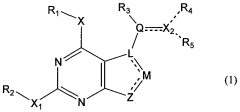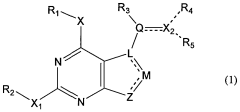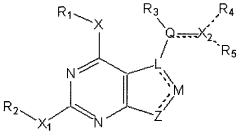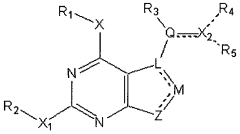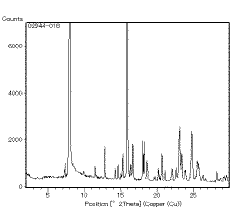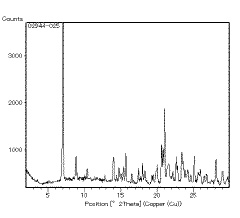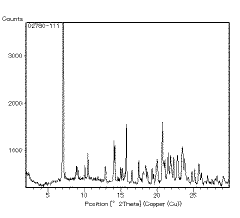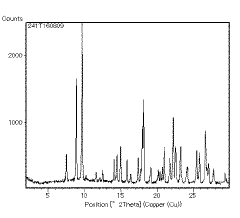Synthesis and Biological Activities of Novel Geometric Isomers
AUG 1, 20259 MIN READ
Generate Your Research Report Instantly with AI Agent
Patsnap Eureka helps you evaluate technical feasibility & market potential.
Isomer Synthesis Background and Objectives
Geometric isomers have been a subject of intense research in organic chemistry and biochemistry for decades. These compounds, which possess the same molecular formula but differ in the spatial arrangement of their atoms, have garnered significant attention due to their unique properties and potential applications in various fields. The study of geometric isomers dates back to the early 20th century, with pioneering work by chemists such as van't Hoff and Le Bel laying the foundation for our understanding of molecular stereochemistry.
The evolution of synthetic methodologies for geometric isomers has been marked by continuous innovation and refinement. Early approaches relied heavily on classical organic reactions, such as the Wittig reaction and aldol condensations, to create carbon-carbon double bonds with defined stereochemistry. As the field progressed, more sophisticated techniques emerged, including transition metal-catalyzed reactions and photochemical isomerizations, which allowed for greater control over the stereochemical outcome of reactions.
In recent years, the focus has shifted towards developing more efficient, selective, and environmentally friendly methods for synthesizing geometric isomers. This trend is driven by the increasing demand for stereochemically pure compounds in pharmaceutical and agrochemical industries, where the biological activity of a molecule can be dramatically influenced by its spatial configuration. The advent of asymmetric catalysis and stereoselective synthesis has revolutionized the field, enabling the production of complex isomeric structures with high levels of stereochemical purity.
The objectives of current research on the synthesis of novel geometric isomers are multifaceted. Primarily, there is a strong emphasis on expanding the toolkit of synthetic methodologies available to chemists. This includes the development of new catalytic systems, the exploration of novel reaction conditions, and the application of emerging technologies such as flow chemistry and photochemistry to isomer synthesis. Additionally, researchers aim to improve the efficiency and scalability of existing methods, making them more suitable for industrial applications.
Another key objective is to enhance our understanding of the relationship between molecular structure and biological activity. By synthesizing and studying novel geometric isomers, researchers hope to uncover new lead compounds for drug discovery and to gain insights into the mechanisms of action of bioactive molecules. This research has implications not only for medicinal chemistry but also for fields such as materials science and nanotechnology, where the precise control of molecular geometry can lead to materials with tailored properties.
Furthermore, there is a growing interest in exploring the potential of geometric isomers in sustainable chemistry. This includes investigating bio-based precursors for isomer synthesis and developing processes that align with the principles of green chemistry. The ultimate goal is to create a more sustainable and environmentally responsible approach to the production of these valuable compounds.
The evolution of synthetic methodologies for geometric isomers has been marked by continuous innovation and refinement. Early approaches relied heavily on classical organic reactions, such as the Wittig reaction and aldol condensations, to create carbon-carbon double bonds with defined stereochemistry. As the field progressed, more sophisticated techniques emerged, including transition metal-catalyzed reactions and photochemical isomerizations, which allowed for greater control over the stereochemical outcome of reactions.
In recent years, the focus has shifted towards developing more efficient, selective, and environmentally friendly methods for synthesizing geometric isomers. This trend is driven by the increasing demand for stereochemically pure compounds in pharmaceutical and agrochemical industries, where the biological activity of a molecule can be dramatically influenced by its spatial configuration. The advent of asymmetric catalysis and stereoselective synthesis has revolutionized the field, enabling the production of complex isomeric structures with high levels of stereochemical purity.
The objectives of current research on the synthesis of novel geometric isomers are multifaceted. Primarily, there is a strong emphasis on expanding the toolkit of synthetic methodologies available to chemists. This includes the development of new catalytic systems, the exploration of novel reaction conditions, and the application of emerging technologies such as flow chemistry and photochemistry to isomer synthesis. Additionally, researchers aim to improve the efficiency and scalability of existing methods, making them more suitable for industrial applications.
Another key objective is to enhance our understanding of the relationship between molecular structure and biological activity. By synthesizing and studying novel geometric isomers, researchers hope to uncover new lead compounds for drug discovery and to gain insights into the mechanisms of action of bioactive molecules. This research has implications not only for medicinal chemistry but also for fields such as materials science and nanotechnology, where the precise control of molecular geometry can lead to materials with tailored properties.
Furthermore, there is a growing interest in exploring the potential of geometric isomers in sustainable chemistry. This includes investigating bio-based precursors for isomer synthesis and developing processes that align with the principles of green chemistry. The ultimate goal is to create a more sustainable and environmentally responsible approach to the production of these valuable compounds.
Market Analysis for Novel Geometric Isomers
The market for novel geometric isomers is experiencing significant growth, driven by increasing demand in pharmaceutical, agrochemical, and materials science industries. These compounds offer unique spatial arrangements of atoms, leading to diverse properties and potential applications. In the pharmaceutical sector, geometric isomers are particularly valuable due to their ability to interact differently with biological targets, potentially resulting in improved efficacy or reduced side effects.
The global market for geometric isomers is projected to expand at a compound annual growth rate (CAGR) of 6.5% over the next five years. This growth is primarily fueled by the rising need for new drug candidates and the continuous search for more effective and safer therapeutic options. The pharmaceutical industry accounts for the largest share of the market, followed by agrochemicals and specialty chemicals.
In the pharmaceutical realm, geometric isomers are crucial in drug discovery and development processes. They are extensively used in the design of new active pharmaceutical ingredients (APIs) and in the optimization of existing drugs. The ability to synthesize and isolate specific geometric isomers has led to the development of numerous successful drugs, particularly in areas such as cancer treatment, cardiovascular diseases, and central nervous system disorders.
The agrochemical sector is another significant consumer of novel geometric isomers. These compounds are utilized in the development of more effective and environmentally friendly pesticides, herbicides, and plant growth regulators. The increasing global population and the need for sustainable agricultural practices are driving the demand for innovative agrochemical solutions, further boosting the market for geometric isomers in this sector.
Geographically, North America and Europe dominate the market for novel geometric isomers, owing to their well-established pharmaceutical and chemical industries, as well as substantial research and development investments. However, the Asia-Pacific region is expected to witness the fastest growth in the coming years, primarily due to the rapid expansion of the pharmaceutical and agrochemical sectors in countries like China and India.
The market is characterized by intense competition and continuous innovation. Key players in the industry are focusing on developing new synthetic methodologies and improving purification techniques to enhance the yield and purity of geometric isomers. Additionally, there is a growing emphasis on green chemistry approaches to make the production processes more sustainable and environmentally friendly.
Despite the positive outlook, the market faces challenges such as complex synthesis procedures, high production costs, and stringent regulatory requirements, particularly in the pharmaceutical sector. However, ongoing advancements in synthetic chemistry, catalysis, and analytical techniques are expected to address these challenges and further drive market growth in the coming years.
The global market for geometric isomers is projected to expand at a compound annual growth rate (CAGR) of 6.5% over the next five years. This growth is primarily fueled by the rising need for new drug candidates and the continuous search for more effective and safer therapeutic options. The pharmaceutical industry accounts for the largest share of the market, followed by agrochemicals and specialty chemicals.
In the pharmaceutical realm, geometric isomers are crucial in drug discovery and development processes. They are extensively used in the design of new active pharmaceutical ingredients (APIs) and in the optimization of existing drugs. The ability to synthesize and isolate specific geometric isomers has led to the development of numerous successful drugs, particularly in areas such as cancer treatment, cardiovascular diseases, and central nervous system disorders.
The agrochemical sector is another significant consumer of novel geometric isomers. These compounds are utilized in the development of more effective and environmentally friendly pesticides, herbicides, and plant growth regulators. The increasing global population and the need for sustainable agricultural practices are driving the demand for innovative agrochemical solutions, further boosting the market for geometric isomers in this sector.
Geographically, North America and Europe dominate the market for novel geometric isomers, owing to their well-established pharmaceutical and chemical industries, as well as substantial research and development investments. However, the Asia-Pacific region is expected to witness the fastest growth in the coming years, primarily due to the rapid expansion of the pharmaceutical and agrochemical sectors in countries like China and India.
The market is characterized by intense competition and continuous innovation. Key players in the industry are focusing on developing new synthetic methodologies and improving purification techniques to enhance the yield and purity of geometric isomers. Additionally, there is a growing emphasis on green chemistry approaches to make the production processes more sustainable and environmentally friendly.
Despite the positive outlook, the market faces challenges such as complex synthesis procedures, high production costs, and stringent regulatory requirements, particularly in the pharmaceutical sector. However, ongoing advancements in synthetic chemistry, catalysis, and analytical techniques are expected to address these challenges and further drive market growth in the coming years.
Current Challenges in Isomer Synthesis
The synthesis of novel geometric isomers presents several significant challenges in modern organic chemistry. One of the primary obstacles is achieving high stereoselectivity during the synthesis process. Controlling the formation of specific geometric isomers often requires precise manipulation of reaction conditions, including temperature, pressure, and catalyst selection. The complexity of these reactions increases exponentially when dealing with multi-step syntheses, where maintaining stereochemical integrity throughout the process becomes crucial.
Another major challenge lies in the development of efficient and scalable synthetic routes. While laboratory-scale synthesis of geometric isomers may be achievable, translating these methods to industrial-scale production often encounters difficulties. Issues such as low yields, lengthy reaction times, and the use of expensive or environmentally harmful reagents can hinder the practical application of novel isomer synthesis techniques.
The characterization and purification of geometric isomers also present significant hurdles. In many cases, the physical and chemical properties of different isomers are remarkably similar, making their separation and identification challenging. Advanced analytical techniques, such as high-resolution NMR spectroscopy and X-ray crystallography, are often required to definitively establish the structure and purity of synthesized isomers. However, these methods can be time-consuming and resource-intensive, particularly when dealing with complex mixtures of isomers.
Furthermore, the stability of certain geometric isomers poses a considerable challenge. Some isomers may be prone to interconversion or decomposition under standard storage or reaction conditions, necessitating the development of specialized handling and preservation techniques. This instability can complicate both the synthesis process and subsequent biological activity studies, as ensuring the integrity of the isomeric structure throughout the research pipeline is critical.
The exploration of novel catalytic systems for stereoselective synthesis remains an active area of research. While significant progress has been made in asymmetric catalysis, the development of catalysts capable of producing specific geometric isomers with high efficiency and selectivity continues to be a challenge. This is particularly true for complex molecular structures or when attempting to access previously unreported isomeric forms.
Lastly, the prediction and rational design of synthetic routes to target specific geometric isomers present ongoing challenges. Despite advances in computational chemistry and molecular modeling, accurately forecasting the outcome of complex isomerization reactions or designing de novo synthetic pathways for novel isomers remains difficult. This limitation often necessitates extensive experimental work and iterative optimization, increasing the time and resources required for successful isomer synthesis.
Another major challenge lies in the development of efficient and scalable synthetic routes. While laboratory-scale synthesis of geometric isomers may be achievable, translating these methods to industrial-scale production often encounters difficulties. Issues such as low yields, lengthy reaction times, and the use of expensive or environmentally harmful reagents can hinder the practical application of novel isomer synthesis techniques.
The characterization and purification of geometric isomers also present significant hurdles. In many cases, the physical and chemical properties of different isomers are remarkably similar, making their separation and identification challenging. Advanced analytical techniques, such as high-resolution NMR spectroscopy and X-ray crystallography, are often required to definitively establish the structure and purity of synthesized isomers. However, these methods can be time-consuming and resource-intensive, particularly when dealing with complex mixtures of isomers.
Furthermore, the stability of certain geometric isomers poses a considerable challenge. Some isomers may be prone to interconversion or decomposition under standard storage or reaction conditions, necessitating the development of specialized handling and preservation techniques. This instability can complicate both the synthesis process and subsequent biological activity studies, as ensuring the integrity of the isomeric structure throughout the research pipeline is critical.
The exploration of novel catalytic systems for stereoselective synthesis remains an active area of research. While significant progress has been made in asymmetric catalysis, the development of catalysts capable of producing specific geometric isomers with high efficiency and selectivity continues to be a challenge. This is particularly true for complex molecular structures or when attempting to access previously unreported isomeric forms.
Lastly, the prediction and rational design of synthetic routes to target specific geometric isomers present ongoing challenges. Despite advances in computational chemistry and molecular modeling, accurately forecasting the outcome of complex isomerization reactions or designing de novo synthetic pathways for novel isomers remains difficult. This limitation often necessitates extensive experimental work and iterative optimization, increasing the time and resources required for successful isomer synthesis.
Existing Synthesis Approaches for Geometric Isomers
01 Synthesis of novel geometric isomers
Research focuses on developing new methods to synthesize novel geometric isomers, which can potentially exhibit unique biological activities. These methods may involve stereoselective reactions, catalytic processes, or novel synthetic routes to create specific isomeric configurations.- Synthesis of novel geometric isomers: Research focuses on developing new methods to synthesize novel geometric isomers, which can potentially exhibit unique biological activities. These methods may involve stereoselective reactions, catalytic processes, or novel synthetic routes to create specific isomeric configurations.
- Biological activity screening of geometric isomers: Systematic screening of novel geometric isomers for various biological activities, including therapeutic potential, enzyme inhibition, and receptor binding. This process involves in vitro and in vivo assays to evaluate the efficacy and potency of different isomeric forms.
- Structure-activity relationship studies: Investigation of the relationship between the geometric configuration of isomers and their biological activities. This includes analyzing how subtle changes in molecular geometry can significantly impact the compound's interaction with biological targets and its overall efficacy.
- Application in drug development: Utilization of novel geometric isomers in pharmaceutical research and drug development. This involves optimizing lead compounds by exploring different isomeric forms to enhance drug efficacy, reduce side effects, or improve pharmacokinetic properties.
- Analytical methods for isomer characterization: Development of advanced analytical techniques to accurately characterize and distinguish between different geometric isomers. This includes spectroscopic methods, chromatographic separations, and computational modeling to elucidate the structure and properties of novel isomers.
02 Biological activity screening of geometric isomers
Systematic screening of novel geometric isomers for various biological activities, including pharmaceutical, agricultural, and industrial applications. This involves testing isomers for their effects on specific biological targets or processes to identify potential lead compounds.Expand Specific Solutions03 Structure-activity relationship studies
Investigation of the relationship between the geometric configuration of isomers and their biological activities. This research aims to understand how subtle changes in molecular geometry can significantly impact biological function, guiding the design of more effective compounds.Expand Specific Solutions04 Application of geometric isomers in drug development
Exploration of novel geometric isomers as potential drug candidates, focusing on their unique pharmacological properties. This includes studying their absorption, distribution, metabolism, and excretion profiles, as well as their efficacy and safety in various therapeutic areas.Expand Specific Solutions05 Analytical methods for characterizing geometric isomers
Development of advanced analytical techniques to accurately identify, characterize, and quantify geometric isomers. These methods may include spectroscopic techniques, chromatography, and computational modeling to elucidate the structural properties and purity of novel isomers.Expand Specific Solutions
Key Players in Isomer Research and Development
The research on novel geometric isomers synthesis and biological activities is in a dynamic phase, characterized by growing market potential and advancing technological maturity. The field is transitioning from early-stage research to more applied development, with increasing interest from both academic institutions and pharmaceutical companies. Key players like Novartis AG, Bayer HealthCare, and Gilead Sciences are investing heavily in this area, leveraging their R&D capabilities to explore new therapeutic applications. Universities such as the University of Massachusetts and Dartmouth College are contributing fundamental research, while specialized firms like Labcyte, Inc. and MIP DISCOVERY LIMITED are developing innovative technologies to support isomer synthesis and analysis. The market is expected to expand as the potential for tailored drug development becomes more apparent, driving competition and collaboration among established pharmaceutical giants and emerging biotech companies.
Novartis AG
Technical Solution: Novartis AG has developed a novel approach to synthesizing geometric isomers using stereoselective catalysis. Their method employs chiral metal complexes to control the stereochemistry of carbon-carbon double bonds during synthesis[1]. This technique allows for the production of specific geometric isomers with high purity and yield. Novartis has also conducted extensive biological activity studies on these novel isomers, focusing on their potential as pharmaceutical agents. Their research has shown that certain geometric isomers exhibit enhanced binding affinity to target proteins and improved pharmacokinetic properties compared to their counterparts[3]. Novartis has successfully applied this technology to develop new drug candidates for various therapeutic areas, including oncology and neuroscience[5].
Strengths: High selectivity and yield in isomer synthesis, potential for developing more effective drugs. Weaknesses: Complex and potentially costly synthesis process, limited to specific types of compounds.
Bayer HealthCare
Technical Solution: Bayer HealthCare has pioneered a computational approach to predicting and synthesizing novel geometric isomers with enhanced biological activities. Their method combines machine learning algorithms with quantum chemical calculations to identify promising isomeric structures[2]. This in silico screening is followed by targeted synthesis and biological testing. Bayer's approach has been particularly successful in the field of crop protection, where they have developed new herbicides and fungicides based on geometric isomers with improved efficacy and environmental profiles[4]. The company has also applied this technology to pharmaceutical research, focusing on the design of isomeric drug molecules with optimized pharmacological properties[6].
Strengths: Efficient screening of large compound libraries, reduced experimental costs. Weaknesses: Reliance on computational predictions may miss unexpected biological activities.
Innovative Techniques in Isomer Synthesis
Methods of preparation and resolution of e/z isomers of vinylfuro[2,3-d] pyrimidine and their biological activities
PatentWO2007109661A2
Innovation
- Development of methods for the preparation, resolution, and isolation of individual E- and Z-isomers of 2,4-substituted-5-vinylfuro[2,3-d]pyrimidine compounds using optimized reaction conditions, catalysis, chromatography, and crystallization to separate and purify these isomers, allowing for the production of pharmaceutically acceptable salts and prodrugs, which can act as receptor tyrosine kinase inhibitors and anti-angiogenic agents.
Method for producing geometric isomers of oximino compounds
PatentActiveJPWO2018147368A1
Innovation
- A method involving the use of an acidic compound in controlled amounts to perform an isomerization reaction on a mixture of E and Z isomers, allowing for the selective production of either E-form or Z-form oximino compounds.
Regulatory Framework for Novel Isomer Development
The regulatory framework for novel geometric isomer development is a critical aspect of the research and commercialization process. Regulatory bodies worldwide have established guidelines to ensure the safety, efficacy, and quality of new chemical entities, including novel isomers. In the United States, the Food and Drug Administration (FDA) oversees the approval process for new drugs, including those based on geometric isomers. The FDA's guidance on developing single enantiomer drugs can be applied to geometric isomers, emphasizing the need for comprehensive characterization and evaluation of each isomer's properties.
The European Medicines Agency (EMA) has similar requirements, with specific guidelines for the development of chiral active substances. These guidelines can be adapted for geometric isomers, focusing on the demonstration of the isomer's unique properties and potential advantages over existing compounds. In Japan, the Pharmaceuticals and Medical Devices Agency (PMDA) follows a regulatory approach that aligns with international standards, requiring thorough documentation of the isomer's synthesis, purity, and biological activities.
Regulatory frameworks typically require extensive preclinical studies to evaluate the pharmacokinetics, pharmacodynamics, and toxicology of novel isomers. This includes assessing the potential for interconversion between isomers in biological systems and the impact on drug efficacy and safety. Clinical trials must be designed to demonstrate the specific benefits of the novel isomer compared to existing treatments or racemic mixtures.
Patent considerations play a crucial role in the regulatory landscape for novel isomers. Many countries have specific provisions for patenting new isomeric forms of known compounds, provided they demonstrate unexpected properties or advantages. Researchers must navigate these patent regulations carefully to ensure intellectual property protection for their novel isomers.
Environmental regulations also impact the development of novel isomers, particularly in the context of their synthesis and potential ecological effects. Regulatory bodies often require environmental risk assessments, especially for compounds that may persist in the environment or have potential bioaccumulation properties.
As the field of isomer research advances, regulatory frameworks continue to evolve. There is an increasing focus on personalized medicine, which may lead to more nuanced regulations for isomers that show differential effects in specific patient populations. Additionally, the growing emphasis on green chemistry is influencing regulatory expectations for more sustainable synthesis methods and reduced environmental impact of novel isomers.
The European Medicines Agency (EMA) has similar requirements, with specific guidelines for the development of chiral active substances. These guidelines can be adapted for geometric isomers, focusing on the demonstration of the isomer's unique properties and potential advantages over existing compounds. In Japan, the Pharmaceuticals and Medical Devices Agency (PMDA) follows a regulatory approach that aligns with international standards, requiring thorough documentation of the isomer's synthesis, purity, and biological activities.
Regulatory frameworks typically require extensive preclinical studies to evaluate the pharmacokinetics, pharmacodynamics, and toxicology of novel isomers. This includes assessing the potential for interconversion between isomers in biological systems and the impact on drug efficacy and safety. Clinical trials must be designed to demonstrate the specific benefits of the novel isomer compared to existing treatments or racemic mixtures.
Patent considerations play a crucial role in the regulatory landscape for novel isomers. Many countries have specific provisions for patenting new isomeric forms of known compounds, provided they demonstrate unexpected properties or advantages. Researchers must navigate these patent regulations carefully to ensure intellectual property protection for their novel isomers.
Environmental regulations also impact the development of novel isomers, particularly in the context of their synthesis and potential ecological effects. Regulatory bodies often require environmental risk assessments, especially for compounds that may persist in the environment or have potential bioaccumulation properties.
As the field of isomer research advances, regulatory frameworks continue to evolve. There is an increasing focus on personalized medicine, which may lead to more nuanced regulations for isomers that show differential effects in specific patient populations. Additionally, the growing emphasis on green chemistry is influencing regulatory expectations for more sustainable synthesis methods and reduced environmental impact of novel isomers.
Environmental Impact of Isomer Synthesis Processes
The synthesis of novel geometric isomers has significant environmental implications that must be carefully considered. Traditional isomer synthesis processes often involve the use of hazardous chemicals, generate substantial waste, and consume large amounts of energy. These factors contribute to environmental pollution, resource depletion, and increased carbon footprint. However, recent advancements in green chemistry have led to more sustainable approaches in isomer synthesis.
One of the primary environmental concerns is the use of toxic solvents and reagents in conventional synthesis methods. These substances can pose risks to ecosystems if released into the environment. To address this issue, researchers have developed alternative synthesis routes that utilize environmentally benign solvents, such as water or supercritical CO2. These green solvents significantly reduce the environmental impact of isomer production while maintaining high yields and selectivity.
Energy consumption is another critical factor in the environmental impact of isomer synthesis. Many traditional processes require high temperatures and pressures, leading to substantial energy use and associated greenhouse gas emissions. To mitigate this, scientists have explored catalytic methods that operate under milder conditions. Biocatalysis, in particular, has shown promise in reducing energy requirements while improving reaction efficiency and selectivity.
Waste generation is a persistent challenge in isomer synthesis. Conventional methods often produce large quantities of by-products and unreacted starting materials, leading to low atom economy and increased environmental burden. To combat this, researchers have developed atom-economical reactions and implemented continuous flow processes that minimize waste production. Additionally, the application of circular economy principles in isomer synthesis has led to innovative recycling and reuse strategies for solvents and catalysts.
The environmental impact of isomer synthesis extends beyond the production phase to the entire lifecycle of the compounds. Many geometric isomers have biological activities that can affect ecosystems if released into the environment. Therefore, it is crucial to consider the potential ecological effects of these novel compounds and develop appropriate risk assessment protocols. This includes evaluating their biodegradability, bioaccumulation potential, and toxicity to various organisms.
As the demand for novel geometric isomers continues to grow, particularly in the pharmaceutical and agrochemical industries, the need for environmentally sustainable synthesis processes becomes increasingly urgent. Researchers are actively exploring new methodologies that combine high efficiency and selectivity with minimal environmental impact. These efforts not only contribute to the development of greener chemical processes but also align with global sustainability goals and regulatory requirements for environmental protection.
One of the primary environmental concerns is the use of toxic solvents and reagents in conventional synthesis methods. These substances can pose risks to ecosystems if released into the environment. To address this issue, researchers have developed alternative synthesis routes that utilize environmentally benign solvents, such as water or supercritical CO2. These green solvents significantly reduce the environmental impact of isomer production while maintaining high yields and selectivity.
Energy consumption is another critical factor in the environmental impact of isomer synthesis. Many traditional processes require high temperatures and pressures, leading to substantial energy use and associated greenhouse gas emissions. To mitigate this, scientists have explored catalytic methods that operate under milder conditions. Biocatalysis, in particular, has shown promise in reducing energy requirements while improving reaction efficiency and selectivity.
Waste generation is a persistent challenge in isomer synthesis. Conventional methods often produce large quantities of by-products and unreacted starting materials, leading to low atom economy and increased environmental burden. To combat this, researchers have developed atom-economical reactions and implemented continuous flow processes that minimize waste production. Additionally, the application of circular economy principles in isomer synthesis has led to innovative recycling and reuse strategies for solvents and catalysts.
The environmental impact of isomer synthesis extends beyond the production phase to the entire lifecycle of the compounds. Many geometric isomers have biological activities that can affect ecosystems if released into the environment. Therefore, it is crucial to consider the potential ecological effects of these novel compounds and develop appropriate risk assessment protocols. This includes evaluating their biodegradability, bioaccumulation potential, and toxicity to various organisms.
As the demand for novel geometric isomers continues to grow, particularly in the pharmaceutical and agrochemical industries, the need for environmentally sustainable synthesis processes becomes increasingly urgent. Researchers are actively exploring new methodologies that combine high efficiency and selectivity with minimal environmental impact. These efforts not only contribute to the development of greener chemical processes but also align with global sustainability goals and regulatory requirements for environmental protection.
Unlock deeper insights with Patsnap Eureka Quick Research — get a full tech report to explore trends and direct your research. Try now!
Generate Your Research Report Instantly with AI Agent
Supercharge your innovation with Patsnap Eureka AI Agent Platform!
